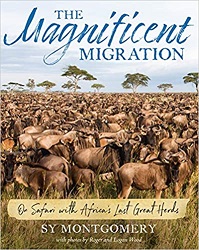
 The Magnificent Migration
The Magnificent MigrationOn Safari with Africa’s Last Great Herds
Review posted February 14, 2021.
Houghton Mifflin Harcourt, 2019. 162 pages.
Starred Review
Review written April 15, 2020, from a library book
2020 Sonderbooks Stand-out:
#6 Longer Nonfiction for Children and Teens
This visually stunning book has taught me so many things about “the greatest of all mammalian migrations” – the wildebeests of the Serengeti. Who knew that the gnu is so hugely important to earth’s environment? I didn’t before reading this book, but I do now.
Here’s a small section from the Introduction:
Like no other event in nature, the wildebeest migration defines wild Africa. The extravagance of their number stupefies: one and a quarter million wildebeests, in separate herds of tens of thousands, all on the move at once, accompanied by hundreds of thousands of zebras and gazelles. It is the largest mass movement of animals on land.
The sheer number of so many animals in motion is a dazzling spectacle. It is a force like gravity, or rainfall – a force that transforms, nourishes, and renews both the land over which they travel and the other creatures who gather in their wake.
Sy Montgomery does insert herself into the book – this is basically the story of her safari to observe wildebeests, traveling with the world’s foremost expert on them. But that added a little drama to the story – would they find a large group of wildebeests, since they don’t travel the same route from year to year? And we learn so much about wildebeests and other animals of Africa along the way. In hearing where they traveled to find the wildebeests, we understood more about the migration and about rutting season for the animals and about all the other animals affected by the migration.
The photographs in this book, taken on her safari, are amazing. The format is extra large, with spreads big as a picture book. There are photographs on every page, but there’s also plenty of text. I ended up being surprised how long it took me to read, because it’s much more than a picture book. Those big pages, which are so nice for the photographs, also hold large amounts of text.
There are many sidebars throughout. They include information about other animals that migrate, other animals of Africa, and even information about a migration that once was even greater than that of the African wildebeests – the American bison. When that population was wiped out, it left a wave of devastation that would also happen if the wildebeests had to stop migrating. The migration itself has a huge effect on the lands and other animals of Africa, and the reader comes to better understand those interactions.
This book is for readers around middle school age. They have to have a long attention span to handle all that text. And they need to be able to handle plenty of information about animals mating and wildebeests rutting. On the very first page, we learn that a lion has tiny barbs on his penis, and lion sex usually ends with a swat and a snarl from the lioness. This is in the context of saying that wildebeests are far more interesting to watch than lions, even if they aren’t nearly as popular for tourists.
For a kid who sticks it out, there’s a very good chance they could end up fascinated by Africa and its wildlife. I learned so much I didn’t know I didn’t know by reading this book packed full of beautiful photographs and information about the animals and environment of Africa.
